Gravitational lens
| Gravitational lensing |
|---|
|
Introduction Formalism Strong lensing Microlensing Weak lensing |
|
Strong lens systems |
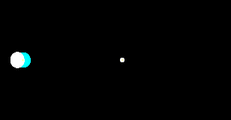
| General relativity | ||||||
|---|---|---|---|---|---|---|
 | ||||||
|
Fundamental concepts |
||||||
|
||||||
A gravitational lens is a distribution of matter (such as a cluster of galaxies) between a distant light source and an observer, that is capable of bending the light from the source as the light travels towards the observer. This effect is known as gravitational lensing, and the amount of bending is one of the predictions of Albert Einstein's general theory of relativity.[1][2] (Classical physics also predicts the bending of light, but only half that predicted by general relativity.[3])
Although either Orest Khvolson (1924) or Frantisek Link (1936) is sometimes credited as being the first to discuss the effect in print, the effect is more commonly associated with Einstein, who published a more famous article on the subject in 1936.
Fritz Zwicky posited in 1937 that the effect could allow galaxy clusters to act as gravitational lenses. It was not until 1979 that this effect was confirmed by observation of the so-called "Twin QSO" SBS 0957+561.
Description
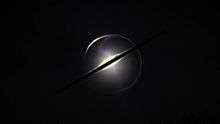
_-vid-.webm.jpg)
_2.webm.jpg)
Unlike an optical lens, a gravitational lens bends to the maximum light that passes closest to its center, and to a minimum light that travels furthest from its center. Consequently, a gravitational lens has no single focal point, but a focal line. The term "lens" in the context of gravitational light deflection was first used by O.J. Lodge, who remarked that it is "not permissible to say that the solar gravitational field acts like a lens, for it has no focal length".[4] If the (light) source, the massive lensing object, and the observer lie in a straight line, the original light source will appear as a ring around the massive lensing object. If there is any misalignment, the observer will see an arc segment instead. This phenomenon was first mentioned in 1924 by the St. Petersburg physicist Orest Chwolson,[5] and quantified by Albert Einstein in 1936. It is usually referred to in the literature as an Einstein ring, since Chwolson did not concern himself with the flux or radius of the ring image. More commonly, where the lensing mass is complex (such as a galaxy group or cluster) and does not cause a spherical distortion of space–time, the source will resemble partial arcs scattered around the lens. The observer may then see multiple distorted images of the same source; the number and shape of these depending upon the relative positions of the source, lens, and observer, and the shape of the gravitational well of the lensing object.[6]
There are three classes of gravitational lensing:[4][7]
1. Strong lensing: where there are easily visible distortions such as the formation of Einstein rings, arcs, and multiple images.
2. Weak lensing: where the distortions of background sources are much smaller and can only be detected by analyzing large numbers of sources in a statistical way to find coherent distortions of only a few percent. The lensing shows up statistically as a preferred stretching of the background objects perpendicular to the direction to the center of the lens. By measuring the shapes and orientations of large numbers of distant galaxies, their orientations can be averaged to measure the shear of the lensing field in any region. This, in turn, can be used to reconstruct the mass distribution in the area: in particular, the background distribution of dark matter can be reconstructed. Since galaxies are intrinsically elliptical and the weak gravitational lensing signal is small, a very large number of galaxies must be used in these surveys. These weak lensing surveys must carefully avoid a number of important sources of systematic error: the intrinsic shape of galaxies, the tendency of a camera's point spread function to distort the shape of a galaxy and the tendency of atmospheric seeing to distort images must be understood and carefully accounted for. The results of these surveys are important for cosmological parameter estimation, to better understand and improve upon the Lambda-CDM model, and to provide a consistency check on other cosmological observations. They may also provide an important future constraint on dark energy.
3. Microlensing: where no distortion in shape can be seen but the amount of light received from a background object changes in time. The lensing object may be stars in the Milky Way in one typical case, with the background source being stars in a remote galaxy, or, in another case, an even more distant quasar. The effect is small, such that (in the case of strong lensing) even a galaxy with a mass more than 100 billion times that of the Sun will produce multiple images separated by only a few arcseconds. Galaxy clusters can produce separations of several arcminutes. In both cases the galaxies and sources are quite distant, many hundreds of megaparsecs away from our Galaxy.
Gravitational lenses act equally on all kinds of electromagnetic radiation, not just visible light. Weak lensing effects are being studied for the cosmic microwave background as well as galaxy surveys. Strong lenses have been observed in radio and x-ray regimes as well. If a strong lens produces multiple images, there will be a relative time delay between two paths: that is, in one image the lensed object will be observed before the other image.
History

Henry Cavendish in 1784 (in an unpublished manuscript) and Johann Georg von Soldner in 1801 (published in 1804) had pointed out that Newtonian gravity predicts that starlight will bend around a massive object[8] as had already been supposed by Isaac Newton in 1704 in his famous Queries No.1 in his book Opticks.[9] The same value as Soldner's was calculated by Einstein in 1911 based on the equivalence principle alone.[10] However, Einstein noted in 1915, in the process of completing general relativity, that his (and thus Soldner's) 1911-result is only half of the correct value. Einstein became the first to calculate the correct value for light bending.[11]
The first observation of light deflection was performed by noting the change in position of stars as they passed near the Sun on the celestial sphere. The observations were performed in May 1919 by Arthur Eddington, Frank Watson Dyson, and their collaborators during a total solar eclipse.[12] The solar eclipse allowed the stars near the Sun to be observed. Observations were made simultaneously in the cities of Sobral, Ceará, Brazil and in São Tomé and Príncipe on the west coast of Africa.[13] The observations demonstrated that the light from stars passing close to the Sun was slightly bent, so that stars appeared slightly out of position.[14]
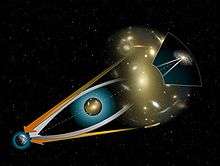

The result was considered spectacular news and made the front page of most major newspapers. It made Einstein and his theory of general relativity world-famous. When asked by his assistant what his reaction would have been if general relativity had not been confirmed by Eddington and Dyson in 1919, Einstein famously made the quip: "Then I would feel sorry for the dear Lord. The theory is correct anyway." [15]
Even before his breakthrough in the formulation of general relativity, Einstein realized that due to light deflection it was also possible that a mass could deflect light along two different paths causing the observer to see multiple images of a single source; this effect would make the mass act as a kind of gravitational lens. However, as he only considered the effect in relation to single stars, he seemed to conclude that the phenomenon was unlikely to be observed for the foreseeable future since the necessary alignments between stars and observer would be highly improbable. Several other physicists speculated about gravitational lensing as well, but all reached the same conclusion that it would be nearly impossible to observe.[16]
In 1936, after some urging by Rudi W. Mandl, Einstein reluctantly published the short article "Lens-Like Action of a Star By the Deviation of Light In the Gravitational Field" in the journal Science.[16]
In 1937, Fritz Zwicky first considered the case where the newly discovered galaxies (which were called 'nebulae' at the time) could act as both source and lens, and that, because of the mass and sizes involved, the effect was much more likely to be observed.[17]
It was not until 1979 that the first gravitational lens would be discovered. It became known as the "Twin QSO" since it initially looked like two identical quasistellar objects. (It is officially named SBS 0957+561.) This gravitational lens was discovered by Dennis Walsh, Bob Carswell, and Ray Weymann using the Kitt Peak National Observatory 2.1 meter telescope.[18]
In the 1980s, astronomers realized that the combination of CCD imagers and computers would allow the brightness of millions of stars to be measured each night. In a dense field, such as the galactic center or the Magellanic clouds, many microlensing events per year could potentially be found. This led to efforts such as Optical Gravitational Lensing Experiment, or OGLE, that have characterized hundreds of such events.
Explanation in terms of space–time curvature

In general relativity, light follows the curvature of spacetime, hence when light passes around a massive object, it is bent. This means that the light from an object on the other side will be bent towards an observer's eye, just like an ordinary lens. Since light always moves at a constant speed, lensing changes the direction of the velocity of the light, but not the magnitude.
Light rays are the boundary between the future, the spacelike, and the past regions. The gravitational attraction can be viewed as the motion of undisturbed objects in a background curved geometry or alternatively as the response of objects to a force in a flat geometry. The angle of deflection is:
toward the mass M at a distance r from the affected radiation, where G is the universal constant of gravitation and c is the speed of light in a vacuum.
Since the Schwarzschild radius is defined as , this can also be expressed in simple form as
Search for gravitational lenses

Most of the gravitational lenses in the past have been discovered accidentally. A search for gravitational lenses in the northern hemisphere (Cosmic Lens All Sky Survey, CLASS), done in radio frequencies using the Very Large Array (VLA) in New Mexico, led to the discovery of 22 new lensing systems, a major milestone. This has opened a whole new avenue for research ranging from finding very distant objects to finding values for cosmological parameters so we can understand the universe better.
A similar search in the southern hemisphere would be a very good step towards complementing the northern hemisphere search as well as obtaining other objectives for study. If such a search is done using well-calibrated and well-parameterized instrument and data, a result similar to the northern survey can be expected. The use of the Australia Telescope 20 GHz (AT20G) Survey data collected using the Australia Telescope Compact Array (ATCA) stands to be such a collection of data. As the data were collected using the same instrument maintaining a very stringent quality of data we should expect to obtain good results from the search. The AT20G survey is a blind survey at 20 GHz frequency in the radio domain of the electromagnetic spectrum. Due to the high frequency used, the chances of finding gravitational lenses increases as the relative number of compact core objects (e.g. Quasars) are higher (Sadler et al. 2006). This is important as the lensing is easier to detect and identify in simple objects compared to objects with complexity in them. This search involves the use of interferometric methods to identify candidates and follow them up at higher resolution to identify them. Full detail of the project is currently under works for publication.
In a 2009 article on Science Daily a team of scientists led by a cosmologist from the U.S. Department of Energy's Lawrence Berkeley National Laboratory has made major progress in extending the use of gravitational lensing to the study of much older and smaller structures than was previously possible by stating that weak gravitational lensing improves measurements of distant galaxies.[19]
Astronomers from the Max Planck Institute for Astronomy in Heidelberg, Germany, the results of which are accepted for publication on Oct 21, 2013 in the Astrophysical Journal Letters (arXiv.org), discovered what at the time was the most distant gravitational lens galaxy termed as J1000+0221 using NASA’s Hubble Space Telescope.[20][21] While it remains the most distant quad-image lensing galaxy known, an even more distant two-image lensing galaxy was subsequently discovered by an international team of astronomers using a combination of Hubble Space Telescope and Keck telescope imaging and spectroscopy. The discovery and analysis of the IRC 0218 lens was published in the Astrophysical Journal Letters on June 23, 2014.[22]
Research published Sep 30, 2013 in the online edition of Physical Review Letters, led by McGill University in Montreal, Québec, Canada, has discovered the B-modes, that are formed due to gravitational lensing effect, using National Science Foundation's South Pole Telescope and with help from the Herschel space observatory. This discovery would open the possibilities of testing the theories of how our universe originated.[23][24]
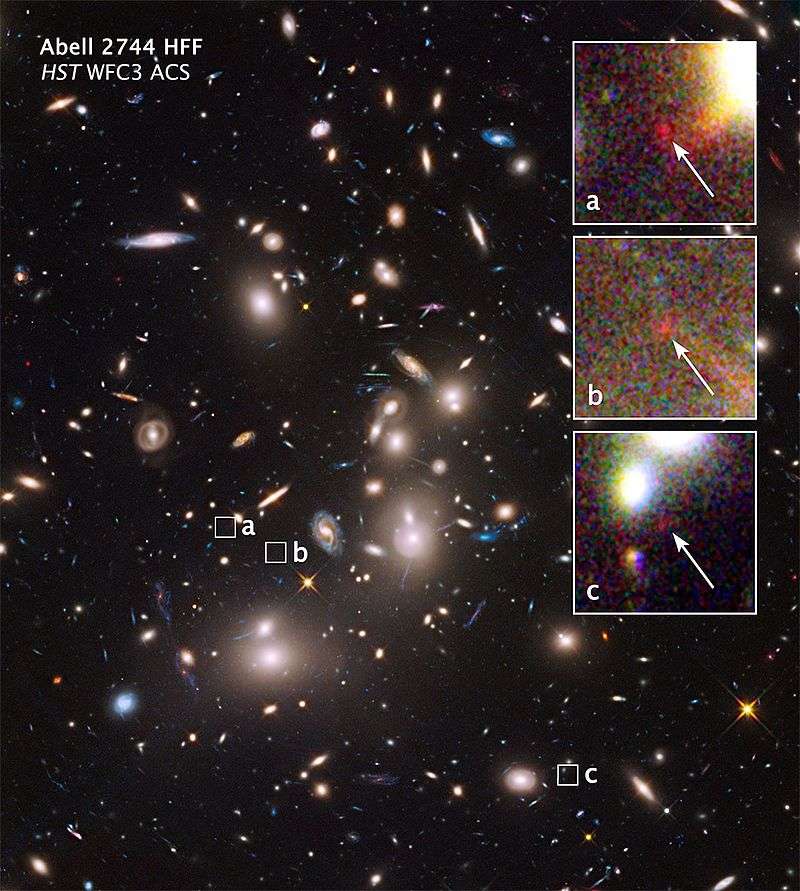
Solar gravitational lens
Albert Einstein predicted in 1936 that rays of light from the same direction that skirt the edges of the Sun would converge to a focal point approximately 542 AU from the Sun.[27] Thus, a probe positioned at this distance (or greater) from the Sun could use the sun as a gravitational lens for magnifying distant objects on the opposite side of the sun[28] A probe's location could shift around as needed to select different targets relative to the Sun.
This distance is far beyond the progress and equipment capabilities of space probes such as Voyager 1, and beyond the known planets and dwarf planets, though over thousands of years 90377 Sedna will move further away on its highly elliptical orbit. The high gain for potentially detecting signals through this lens, such as microwaves at the 21-cm hydrogen line, led to the suggestion by Frank Drake in the early days of SETI that a probe could be sent to this distance. A multipurpose probe SETISAIL and later FOCAL was proposed to the ESA in 1993, but is expected to be a difficult task.[29] If a probe does pass 542 AU, magnification capabilities of the lens will continue to act at further distances, as the rays that come to a focus at larger distances pass further away from the distortions of the Sun's corona.[30]
Measuring weak lensing
Kaiser et al. (1995),[31] Luppino & Kaiser (1997)[32] and Hoekstra et al. (1998) prescribed a method to invert the effects of the Point Spread Function (PSF) smearing and shearing, recovering a shear estimator uncontaminated by the systematic distortion of the PSF. This method (KSB+) is the most widely used method in current weak lensing shear measurements.
Galaxies have random rotations and inclinations. As a result, the shear effects in weak lensing need to be determined by statistically preferred orientations. The primary source of error in lensing measurement is due to the convolution of the PSF with the lensed image. The KSB method measures the ellipticity of a galaxy image. The shear is proportional to the ellipticity. The objects in lensed images are parameterized according to their weighted quadrupole moments. For a perfect ellipse, the weighted quadrupole moments are related to the weighted ellipticity. KSB calculate how a weighted ellipticity measure is related to the shear and use the same formalism to remove the effects of the PSF.
KSB’s primary advantages are its mathematical ease and relatively simple implementation. However, KSB is based on a key assumption that the PSF is circular with an anisotropic distortion. It’s fine for current cosmic shear surveys, but the next generation of surveys (e.g. LSST) may need much better accuracy than KSB can provide. Because during that time, the statistical errors from the data are negligible, the systematic errors will dominate.
Gallery
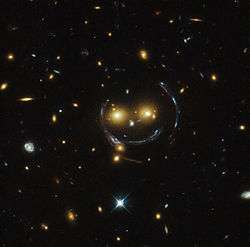 "Smiley" image of galaxy cluster (SDSS J1038+4849) & gravitational lensing (an Einstein ring) (HST).[33]
"Smiley" image of galaxy cluster (SDSS J1038+4849) & gravitational lensing (an Einstein ring) (HST).[33] Abell 1689 - actual gravitational lensing effects (Hubble Space Telescope).
Abell 1689 - actual gravitational lensing effects (Hubble Space Telescope). Dark matter distribution - weak gravitational lensing (Hubble Space Telescope).
Dark matter distribution - weak gravitational lensing (Hubble Space Telescope).
 Gravitational lens with the Einstein equations, Museum Boerhaave, Leiden
Gravitational lens with the Einstein equations, Museum Boerhaave, Leiden

See also
Historical papers and references
- Chwolson, O (1924). "Über eine mögliche Form fiktiver Doppelsterne". Astronomische Nachrichten. 221 (20): 329–330. Bibcode:1924AN....221..329C. doi:10.1002/asna.19242212003.
- Einstein, Albert (1936). "Lens-like Action of a Star by the Deviation of Light in the Gravitational Field". Science. 84 (2188): 506–7. Bibcode:1936Sci....84..506E. doi:10.1126/science.84.2188.506. JSTOR 1663250. PMID 17769014.
- Renn, Jürgen; Tilman Sauer; John Stachel (1997). "The Origin of Gravitational Lensing: A Postscript to Einstein's 1936 Science paper". Science. 275 (5297): 184–6. Bibcode:1997Sci...275..184R. doi:10.1126/science.275.5297.184. PMID 8985006.
References
- Notes
- ↑ Drakeford, Jason; Corum, Jonathan; Overbye, Dennis (March 5, 2015). "Einstein's Telescope - video (02:32)". New York Times. Retrieved December 27, 2015.
- ↑ Overbye, Dennis (March 5, 2015). "Astronomers Observe Supernova and Find They're Watching Reruns". New York Times. Retrieved March 5, 2015.
- ↑ Cf. Kennefick 2005 for the classic early measurements by the Eddington expeditions; for an overview of more recent measurements, see Ohanian & Ruffini 1994, ch. 4.3. For the most precise direct modern observations using quasars, cf. Shapiro et al. 2004
- 1 2 Schneider, Peter; Ehlers, Jürgen; Falco, Emilio E. (1992). Gravitational Lenses. Springer-Verlag Berlin Heidelberg New York Press. ISBN 3-540-97070-3.
- ↑ Gravity Lens – Part 2 (Great Moments in Science, ABS Science)
- ↑ Dieter Brill, "Black Hole Horizons and How They Begin", Astronomical Review (2012); Online Article, cited Sept.2012.
- ↑ Melia, Fulvio (2007). The Galactic Supermassive Black Hole. Princeton University Press. pp. 255–256. ISBN 0-691-13129-5.
- ↑ Soldner, J. G. V. (1804). "On the deflection of a light ray from its rectilinear motion, by the attraction of a celestial body at which it nearly passes by". Berliner Astronomisches Jahrbuch: 161–172.
- ↑ Newton, Isaac (1998). Opticks: or, a treatise of the reflexions, refractions, inflexions and colours of light. Also two treatises of the species and magnitude of curvilinear figures. Commentary by Nicholas Humez (Octavo ed.). Palo Alto, Calif.: Octavo. ISBN 1-891788-04-3. (Opticks was originally published in 1704).
- ↑ Schneider, Peter; Ehlers, Jürgen; Falco, Emilio E. (1992). Gravitational Lenses. Springer-Verlag Berlin Heidelberg New York Press. ISBN 3-540-97070-3.
- ↑ Will, C.M. (2006). "The Confrontation between General Relativity and Experiment". Living Reviews in Relativity. 9: 39. arXiv:gr-qc/0510072
 . Bibcode:2006LRR.....9....3W. doi:10.12942/lrr-2006-3.
. Bibcode:2006LRR.....9....3W. doi:10.12942/lrr-2006-3. - ↑ Dyson, F. W.; Eddington, A. S.; Davidson C. (1920). "A determination of the deflection of light by the Sun's gravitational field, from observations made at the total eclipse of 29 May 1919". Philosophical Transactions of the Royal Society. 220A: 291–333. Bibcode:1920RSPTA.220..291D. doi:10.1098/rsta.1920.0009.
- ↑ Stanley, Matthew (2003). "'An Expedition to Heal the Wounds of War': The 1919 Eclipse and Eddington as Quaker Adventurer". Isis. 94 (1): 57–89. doi:10.1086/376099. PMID 12725104.
- ↑ Dyson, F. W.; Eddington, A. S.; Davidson, C. (1 January 1920). "A Determination of the Deflection of Light by the Sun's Gravitational Field, from Observations Made at the Total Eclipse of May 29, 1919". Philosophical Transactions of the Royal Society A: Mathematical, Physical and Engineering Sciences. 220 (571-581): 291–333. Bibcode:1920RSPTA.220..291D. doi:10.1098/rsta.1920.0009.
- ↑ Rosenthal-Schneider, Ilse: Reality and Scientific Truth. Detroit: Wayne State University Press, 1980. p 74. (See also Calaprice, Alice: The New Quotable Einstein. Princeton: Princeton University Press, 2005. p 227.)
- 1 2 "A brief history of gravitational lensing — Einstein Online". www.einstein-online.info. Retrieved 2016-06-29.
- ↑ F. Zwicky (1937). "Nebulae as Gravitational lenses" (PDF). Physical Review. 51 (4): 290. Bibcode:1937PhRv...51..290Z. doi:10.1103/PhysRev.51.290.
- ↑ Walsh, D.; Carswell, R. F.; Weymann, R. J. (31 May 1979). "0957 + 561 A, B: twin quasistellar objects or gravitational lens?". Nature. 279 (5712): 381–384. Bibcode:1979Natur.279..381W. doi:10.1038/279381a0. PMID 16068158.
- ↑ Cosmology: Weak gravitational lensing improves measurements of distant galaxies
- ↑ Sci-News.com (21 Oct 2013). "Most Distant Gravitational Lens Discovered". Sci-News.com. Retrieved 22 October 2013.
- ↑ van der Wel, A.; et al. (2013). "Discovery of a Quadruple Lens in CANDELS with a Record Lens Redshift". Astrophysical Journal Letters. 777: L17. arXiv:1309.2826
 . Bibcode:2013ApJ...777L..17V. doi:10.1088/2041-8205/777/1/L17.
. Bibcode:2013ApJ...777L..17V. doi:10.1088/2041-8205/777/1/L17. - ↑ Wong, K.; et al. (2014). "Discovery of a Strong Lensing Galaxy Embedded in a Cluster at z = 1.62". Astrophysical Journal Letters. 789: L31. arXiv:1405.3661
 . Bibcode:2014ApJ...789L..31W. doi:10.1088/2041-8205/789/2/L31.
. Bibcode:2014ApJ...789L..31W. doi:10.1088/2041-8205/789/2/L31. - ↑ NASA/Jet Propulsion Laboratory (October 22, 2013). "Long-sought pattern of ancient light detected". ScienceDaily. Retrieved October 23, 2013.
- ↑ Hanson, D.; et al. (Sep 30, 2013). "Detection of B-Mode Polarization in the Cosmic Microwave Background with Data from the South Pole Telescope". Physical Review Letters. 14. 111. arXiv:1307.5830
 . Bibcode:2013PhRvL.111n1301H. doi:10.1103/PhysRevLett.111.141301.
. Bibcode:2013PhRvL.111n1301H. doi:10.1103/PhysRevLett.111.141301. - ↑ Clavin, Whitney; Jenkins, Ann; Villard, Ray (7 January 2014). "NASA's Hubble and Spitzer Team up to Probe Faraway Galaxies". NASA. Retrieved 8 January 2014.
- ↑ Chou, Felecia; Weaver, Donna (16 October 2014). "RELEASE 14-283 - NASA's Hubble Finds Extremely Distant Galaxy through Cosmic Magnifying Glass". NASA. Retrieved 17 October 2014.
- ↑ Einstein, Albert (1936). "Lens-Like Action of a Star by the Deviation of Light in the Gravitational Field". Science. 84 (2188): 506–507. Bibcode:1936Sci....84..506E. doi:10.1126/science.84.2188.506. PMID 17769014.
- ↑ Eshleman, Von R. (1979). "Gravitational lens of the sun: its potential for observations and communications over interstellar distances," Science, 205 (4411): 1133-1135.
- ↑ Geoffrey A. Landis, "Mission to the Gravitational Focus of the Sun: A Critical Analysis," ArXiv, paper 1604.06351, Cornell University, 21 Apr 2016 (downloaded 30 April 2016)
- ↑ Claudio Maccone (2009). Deep Space Flight and Communications: Exploiting the Sun as a Gravitational Lens. Springer.
- ↑ Kaiser, Nick; Squires, Gordon; Broadhurst, Tom (August 1995). "A Method for Weak Lensing Observations". The Astrophysical Journal. 449: 460. arXiv:astro-ph/9411005
 . Bibcode:1995ApJ...449..460K. doi:10.1086/176071.
. Bibcode:1995ApJ...449..460K. doi:10.1086/176071. - ↑ Luppino, G. A.; Kaiser, Nick (20 January 1997). "Detection of Weak Lensing by a Cluster of Galaxies at z = 0.83". The Astrophysical Journal. 475 (1): 20–28. arXiv:astro-ph/9601194
 . Bibcode:1997ApJ...475...20L. doi:10.1086/303508.
. Bibcode:1997ApJ...475...20L. doi:10.1086/303508. - ↑ Loff, Sarah; Dunbar, Brian (February 10, 2015). "Hubble Sees A Smiling Lens". NASA. Retrieved February 10, 2015.
- ↑ "Most distant gravitational lens helps weigh galaxies". ESA/Hubble Press Release. Retrieved 18 October 2013.
- ↑ "ALMA Rewrites History of Universe's Stellar Baby Boom". ESO. Retrieved 2 April 2013.
- Bibliography
- "Accidental Astrophysicists". Science News, June 13, 2008.
- "XFGLenses". A Computer Program to visualize Gravitational Lenses, Francisco Frutos-Alfaro
- "G-LenS". A Point Mass Gravitational Lens Simulation, Mark Boughen.
- Newbury, Pete, "Gravitational Lensing". Institute of Applied Mathematics, The University of British Columbia.
- Cohen, N., "Gravity's Lens: Views of the New Cosmology", Wiley and Sons, 1988.
- "Q0957+561 Gravitational Lens". Harvard.edu.
- Bridges, Andrew, "Most distant known object in universe discovered". Associated Press. February 15, 2004. (Farthest galaxy found by gravitational lensing, using Abell 2218 and Hubble Space Telescope.)
- Analyzing Corporations ... and the Cosmos An unusual career path in gravitational lensing.
- "HST images of strong gravitational lenses". Harvard-Smithsonian Center for Astrophysics.
- "A planetary microlensing event" and "A Jovian-mass Planet in Microlensing Event OGLE-2005-BLG-071", the first extra-solar planet detections using microlensing.
- Gravitational lensing on arxiv.org
- NRAO CLASS home page
- AT20G survey
- A diffraction limit on the gravitational lens effect (Bontz, R. J. and Haugan, M. P. "Astrophysics and Space Science" vol. 78, no. 1, p. 199-210. August 1981)
- Further reading
- Blandford & Narayan; Narayan, R (1992). "Cosmological applications of gravitational lensing". Annual Review of Astronomy and Astrophysics. 30 (1): 311–358. Bibcode:1992ARA&A..30..311B. doi:10.1146/annurev.aa.30.090192.001523.
- Matthias Bartelmann and Peter Schneider (2000-08-17). "Weak Gravitational Lensing" (PDF).
- Khavinson, Dmitry; Neumann, Genevra (June–July 2008). "From Fundamental Theorem of Algebra to Astrophysics: A "Harmonious" Path" (PDF). Notices of the AMS. 55 (6): 666–675..
- Petters, Arlie O.; Levine, Harold; Wambsganss, Joachim (2001). Singularity Theory and Gravitational Lensing. Progress in Mathematical Physics. 21. Birkhäuser.
- Tools for the evaluation of the possibilities of using parallax measurements of gravitationally lensed sources (Stein Vidar Hagfors Haugan. June 2008)
External links
| Wikimedia Commons has media related to Gravitational lensing. |
- Video: Evalyn Gates – Einstein's Telescope: The Search for Dark Matter and Dark Energy in the Universe, presentation in Portland, Oregon, on April 19, 2009, from the author's recent book tour.
- Audio: Fraser Cain and Dr. Pamela Gay – Astronomy Cast: Gravitational Lensing, May 2007
